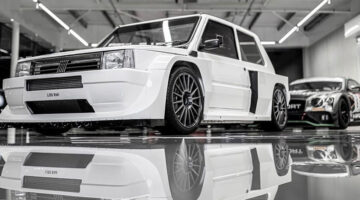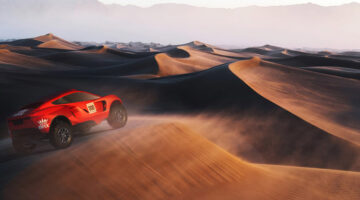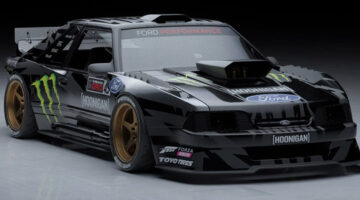The 40th Dakar Rally kicked off on 6 January. Formerly known as the Paris Dakar after its historic start and finish locations, the endurance race is divided into 14 stages and will take entrants 8850 kilometres through South America, starting in Lima, Peru before crossing into Bolivia and finishing up in Cordoba, Argentina.
Consistent with the rally raid competition format, the Dakar is a multi-day race event made up of long off-road stages. The vehicles participating include cars, trucks, bikes and quad bikes that can be run by manufacturer works teams, private individuals or standalone motorsport outfits. Of course, we’ll be focusing on the car-side of things. Keep an eye on this page for live Dakar updates and results from each day of the Dakar race.
Latest news
Day 1 – Lima to Pisco
The opening stage of the rally took competitors 140 kilometres down the west coast of Peru, from Lima to Pisco, before a 19-mile long special stage. Toyota Gazoo Racing SA finished in the top two spots, with Al-Attiyah 16 minutes ahead of Ten Brinke in the team’s sister car. Nicolas Fuchs completed the top three in the Borgward BX7.
Dakr Rookie, Bryce Menzies impressed, edging out his experienced Mini X-Raid teammate Nani Roma by 15 seconds on the special stage to finish 4th. Team Total Peugeot didn’t fare so well: Peterhansel, their highest placed driver, finished 11th, five places ahead of Sainz, and Sebastian Loeb lost his brakes just 3 kilometres in, forcing him down into 27th overall.
Reviewing the first day, Peterhansel said, ‘I didn’t feel comfortable with the headlamps so high. I wasn’t very confident, so I drove like a granny. I spent the entire stage on the defensive. Proportionally, we conceded lots of time to Nasser. Two minutes in 30 kilometres is a big deal. We need to ease into the race, things will work out.’

Day 2 – Pisco
Team Total Peugeot’s fortunes changed on the second day, taking first, second and third through Despres, Peterhansel and Loeb respectively. 90 per cent of the Pisco-based, 165 mile stage was off-track, putting co-drivers’ navigational skills to the test. This was a problem for Toyota Gazoo Racing SA’s, Al-Attiyah, whose co-driver fell ill after just 14 kilometres of the stage, causing them to cross the line 9th on the second day and pushing them down into 5th overall.
After two days’ racing, Despres was top ahead of Pertehanel with Loeb climbing up to 4th after his disappointing opening stage. The rally legend said, ‘I think we posted a decent time and we won’t be opening the road tomorrow, so I think it will be alright. We always follow the track, even though we sometimes suspect that it’s not the right one. But we stay the course because we don’t want to lose it. Our goal is to make it out of Peru in one piece. Failing to find a waypoint can cost you dearly.’
Less than three kilometres into the second stage, Bryce Menzies rolled his X-Raid Mini Buggy (see below), undoing his impressive work yesterday and forcing him to retire with the buggy deemed irreparable and his co-driver suffering a broken ankle. Recalling the accident Menzies said, ‘We hit it pretty fast; it just unloaded the rear and stuck the front bumper, and I think we flipped seven or eight times’.
Dakar drivers
The mix of cars and drivers should ensure the competition will be as fierce as ever with 105 driver and co-driver pairings in the car classes this year. Team Total Peugeot will be fielding a strong driver lineup: thirteen-time Dakar winner Stephane Peterhansel, nine-time WRC champion Sebastien Loeb and Carlos Sainz Snr – father of Torro Rosso F1 driver Carlos Sainz – will all pilot their own Peugeot 3008 DKR Maxis.
Many other drivers with plenty of Dakar experience will be returning in their search for further glory. Nasser Al-Attiyah is hoping to complete a hat-trick of victories while driving for Toyota GAZOO Racing SA, and X-Raid’s Nani Roma will want to build on his past success in the Mini John Cooper Works Rally having won in 2014.
Driving the X-Raid John Cooper Works Buggy, Bryce Menzies, three-time Trophy Truck champion in TORC (The Off-road Championship) has been tipped for success. He had planned to race in the 2017 installment but a crash and the resulting injuries rendered him unfit for entry, but he comes into this year’s race with quiet expectation.

Dakar cars
Peugeot 3008 DKR Maxi
The Maxi is an evolution of the 3008 DKR that gifted Peugeot victory in 2017. The biggest change has seen the suspension track widened by 200mm to improve the Maxi’s stability and handling. Mid-mounted within the Maxi’s steel tubular spaceframe chassis is a 3-litre twin-turbo diesel engine producing 335bhp and 590lb ft of torque. It drives the rear-wheels through a six-speed sequential gearbox. With a 400-litre fuel tank, the Maxi should be able to push towards its 200kph top speed for long periods.
Mini John Cooper Works Rally/Buggy
Two derivatives of Mini will be taking on the Dakar, the all-new Buggy and returning Rally. Both have a BMW straight-six diesel engine producing 335bhp and 590lb ft of torque, but whereas the Rally has a four-wheel drive system, the Buggy is two-wheel drive. Engineering efforts haven’t centered exclusively around the new Buggy though, for this year’s event the Rally has revised suspension and is lighter, too.

Toyota Hilux
The Hilux has reverted to four-wheel drive after a two-wheel drive setup was used in the 2017 car, but the gearbox and naturally aspirated V8 engine have been recycled. The powertrain has, however, been reconfigured to improve performance. The suspension has also been modified to accommodate the change to four-wheel drive, now permitting more suspension travel to improve body control.
Borgward BX7 DKR
The Borgward BX7 gets a petrol engine developing 370bhp and 406lb ft of torque which is deployed through a four-wheel drive system. The presence of twin dampers at each corner should further aid traction by keeping the tyres in contact with the ground more of the time compared to single damper units. The rear brakes, manufactured by Brembo, are water-cooled to maintain optimal operating temperatures and thus maximise braking performance.
Dakar Rally History
Left in awe by his experience in the Libyan desert during the 1977 Abidjan to Nice rally, Thierry Sabine wanted to return there with a rally of his own. He persuaded 182 competitors to sign up for the inaugural Paris Dakar Rally in 1979 and join him on a 6,000-mile journey, passing through five countries over two continents. As you have probably guessed, the race starting in Paris, France and finished in Dakar, Senegal.

While the eponymous start and finish points were fixed for Paris Dakar rallies up until 1992, the route often changed. From 1993, the start and finish locations began to vary as well, with South Africa, Spain and Portugal all featuring. Africa always constituted the bulk of the route up until 2008. In that year, a terrorist attack in Mauritania forced organisers to cancel the event as the route was planned to pass through that country. Since then, the ‘Dakar Rally’ has been held in South America.
Mitsubishi has become the most successful car manufacturer in Dakar history with twelve wins, double that of Peugeot which has the second most. Stephane Peterhansel is the most decorated Dakar driver and rider in history with thirteen victories. His first win came with Yamaha in 1991, before he went on to claim more titles with Nissan, Mitsubishi, BMW, Mini and Peugeot.
This article originally appeared at evo.co.uk



